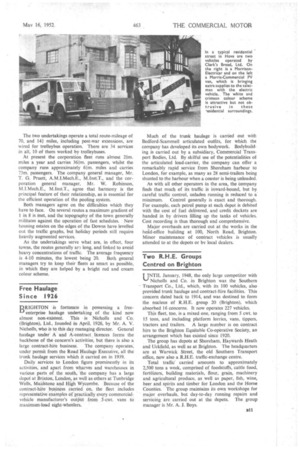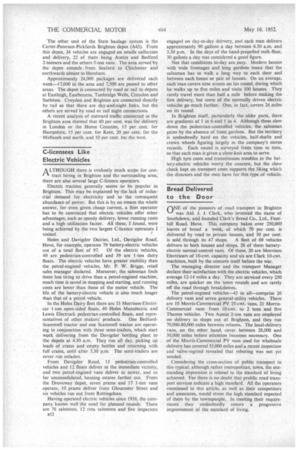Free:Haulage Since 1926
Page 45

Page 46

If you've noticed an error in this article please click here to report it so we can fix it.
BRIGHTON is fortunate in possessing a freeenterprise haulage undertaking of the kind now almost non-existent. This is 'Nicholls and Co. (Brighton), Ltd., founded in April, 1926, by Mr. A. V. Nicholls, who is to this day managing director. General haulage under A and A-contract, licences forms the backbone of the concern's activities, but there is also a large contract-hire business. The company operates, under permit from the Road Haulage Executive, all the trunk haulage services which it carried on in 1939.
Daily services to London figure prominently in its activities, and apart from wharves and warehouses in various parts of the south, the company has a large depot at Brixton, London, as well as.others at Tunbridge Wells, Maidstone and High Wycombe. Because of the contract hire business Carried on the fleet includes representative examples of practically every commercialT vehicle manufacturer's output from 5-cwt. vans to maximum-load eight-wheelers.
Much of the trunk haulage is carried out with Bedford-Scamrnell articulated outfits, for which the company has developed its own bodywork. Bodybuilding is carried out by a subsidiary, Commercial Transport Bodies, Ltd. By skilful use of the potentialities of the articulated load-carrier, the company can offer a remarkably rapid service from Shoreham harbour to London, for example, as many as 28 semi-trailers being shunted to the harbour when a coaster is being unloaded.
As with all other operators in the area, the company finds that much of its traffic is inward-bound, but by careful traffic control, unladen running is reduced to a' minimum. Control generally is exact and thorough. For example, each petrol pump at each depot is debited with the cost of fuel delivered, and credit dockets are handed in by drivers filling up the tanks of vehicles. Cost recording is thus thorough and comprehensive.
Major overhauls are carried out at the works in the head-office building at 100, North Road, Brighton. Minor maintenance of contract vehicles is usually attended to at the depots or by local dealers.
Two R.H.E. Groups Centred on Brighton
UNTIL January, 1948, the only large competitor with Nicholls and Co. in Brighton was the Southern Transport Co., Ltd., which, with its 100 vehicles, also provided trunk haulage and contract-ffire facilities. This concern dated back to 1914, and was destined to form the nucleus of R.H.E. group 20 (Brighton), which absorbed 16 concerns. It now operates 227 vehicles.
This fleet, too, is a mixed one, ranging from 5 cwt. to 15 tons, and including platform lorries, vans, tippers, tractors and trailers. A large number is on contract hire to the Brighton Equitable Co-operative Society, an arrangement which has existed since 1920.
The group has depots at Shoreham, Haywards Heath and Uckfield, as well as at Brighton. The headquarters are at Warwick Street, the old Southern Transport office, now also a R.H.E. traffic-exchange centre.
Total traffic' carried amounts to approximately 2,500 tons a week, comprised of foodstuffs, cattle food, fertilizers, building materials, flour, grain, machinery and agricultural produce, as well as paper, fish, wine, beer and Spirits and timber for London and the Home Counties. The group maintains its own workshops for major overhauls, but day-to-day running repairs and servicing are carried out at the depots. The group manager is Mr. A. J. Boys. The other unit of the State haulage system is the Carter-Paterson-Pickfords Brighton depot (A43). From . this depot, 24 vehicles are engaged on smalls collection and delivery, 22 of them being Austin and Bedford 2-tonners and the others 5-ton vans. The area served by the depot extends from Seaford to Chichester and northwards almost to Horsham.
Approximately 24,000 packages are delivered each week-17,000 in the area and 7,500 are passed to other areas. The depot is connected by road or rail to depots at Eastleigh, Eastbourne, Tunbridge Wells, Croydon and Surbiton. Croydon and Brighton are connected directly by 'rail so that there are day-and-night links, but the others are served by road or rail night connections.
A recent analysis of outward traffic connected in the Brighton area showed that 40 per cent, was for delivery in London or the Home Counties, 15 per cent. for Hampshire, 15 per cent. for Kent, 20 per cent. for the -Midlands and north, and 10 per cent, for the west.
C-licensees Like Electric Vehicles ALTHOUGH there is evidently much scope for contract hiring in Brighton and the surrounding area, there are also several large C-licence operators.
Electric traction generally seems to be popular in Brighton. This may be explained by the lack of industrial demand for electricity and to the consequent abundance of power. But this is by no means the whole answer, for even given cheap current, a fleet operator has to be convinced that electric vehicles offer other advantages; such as speedy delivery, lower running costs and a high utilization factor. All these, I found, were being achieved by the two largest C-licence operators I visited.
Holes and Davigdor Dairies, Ltd., Davigdor Road, Hove, for example, operates 79 battery-electric vehicles out of a total fleet of 97. Of the electric vehicles, 40 are pedestrian-controlled and 39 are 1-ton dairy floats. The electric vehicles have greater mobility than the petrol-engined vehicles, Mr. P. W. Briggs, retail sales manager declared. Moreover, the salesman finds them less tiring to drive than a petrol-engined machine, much time is saved in stopping and starting, and running costs are lower than those of the motor vehicle. The life of the battery-electric vehicle is also much longer than that of a petrol vehicle.
. In the Holes Dairy fleet there are 33 Morrison-Electricar 1-ton open-sided floats, 40 Holes Manulectric and Lewis Eleetruck pedestrian-controlled floats, and repre
sentatives of other makers' products. One BedfordScammell tractor and one Scammell tractor are operating in conjunction with three semi-trailers, which start work delivering from the Davigdor bottling plant to the depots at 4.30 a.m. They run all day, picking up Toads of crates and empty bottles and returning with full crates, until after 5.30 p.m. The semi-trailers are never run unladen:
From Davigdor Road, 13 pedestrian-controlled vehicles and 12 floats deliver in the immediate vicinity, and two petrol-engined vans deliver in newer, and so far unconsolidated, housing estates farther out. From the Droveway depot, seven prams and 17 1-ton vans operate, 10 prams deliver from Gloucester Street and six vehicles run out from Rottingdean.
Having operated electric vehicles since 1936, the company knows well the need for planned rounds. There are 76 salesmen, 12 rota salesmen and five inspectors al 2
engaged on day-to-day delivery, and each man delivers approximately 90 gallons a day between 6.30 a.m. and 3.30 p.m. In the days of the hand-propelled milk-float, 30 gallons a day was considered a good figure.
Not that conditions to-day are easy. Modern houses with wide frontages and long gardens mean that the salesman has to walk a long way to each door and between each house or pair of houses. On an average, each man covers nine streets on his round, during which he walks up to five miles and visits 300 houses. They rarely travel more than half a mile before making the first delivery, but some of the normally driven electric vehicles go much farther. One, in fact, covers 24 miles on its round.
In Brighton itself, particularly the older parts, there are gradients of 1 in 6 and 1 in 4. Although these slow down the pedestrian-controlled vehicles, the salesman gains by the absence of front gardens. But the territory is undoubtedly hard on the vehicles, half-shafts and crown wheels figuring largely in the company's stores records. Each round .is surveyed from time to time, so that each man is given a close-knit area to serve.
High tyre costs and transmission troubles in the battery-electric vehicles worry the concern, but the close check kept on transport costs supports the liking which the directors and the men have for this type of vehicle.
Bread Delivered to the Door nNE of the pioneers of road transport in Brighton was Aid. J. J. Clark, who invented the name of Southdown, and founded Clark's Bread Co., Ltd., Fonthill Road, Hove. This company bakes. over 250,000 loaves of bread a week, of which 70 per cent. is delivered by road to private houses, and 30 per cent.
is sold through its 47 shops. A fleet of. 69 vehicles delivers to both houses and shops, 26 of them batteryelectric normal-control vans. Of these, 20 are Morrison Electricars of 10-cwt. capacity and six are Clark 10-cwt. machines, built by the concern itself before the war.
The managing director and the transport Manager declare their satisfaction with the electric vehicles, which average 12-14 miles a day. They are serviced every 250 miles, are quicker on the town. rounds and are rarely off the road through breakdowns.
The petrol-engined vehicles-43 in all—comprise 36 delivery vans and seven general-utility vehicles. There are 10 Morris-Commercial PV 25-cwt. vans, 21 MorrisCommercial vans from 10-cwt. to 2 tons and five Thames vehicles. Two Austin 2-ton vans are employed on delivery to shops out of Brighton, and they run 70,000-80,000 miles between rebores. The local-delivery vans, on the other hand, cover between 28,000 and 30,000 miles before attention becomes necessary. One of the Morris-Commercial PV vans used for wholesale delivery has covered 35,000 miles and a recent inspection and valve-regrind revealed that reboring was not yet needed.
Considering the cross-section of public transport in this typical, although rather metropolitan, town, the outstanding impression is related to the standard of living achieved. For there is no doubt that prolific road transport services indicate a high standard. All the operators mentioned in this article, as well as their competitors and associates, would stress the high standard expected of them by the.towrtspeople. In meeting their requirements they undoubtedly ensure a progressive improvement of the standard of living.




















































































